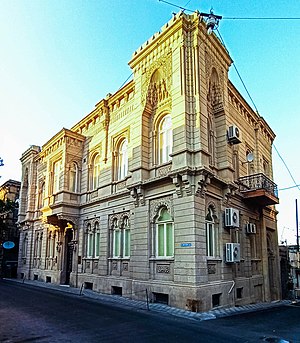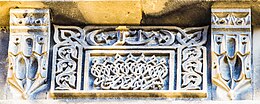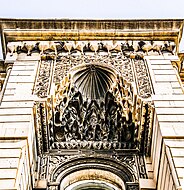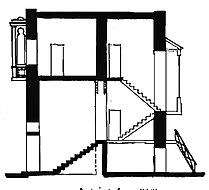
Baku is the capital and largest city of Azerbaijan, as well as the largest city on the Caspian Sea and of the Caucasus region. Baku is located 28 metres (92 ft) below sea level, which makes it the lowest lying national capital in the world and also the largest city in the world located below sea level. Baku lies on the southern shore of the Absheron Peninsula, alongside the Bay of Baku. At the beginning of 2009, Baku's urban population was estimated at just over two million people. Officially, about 25% of all inhabitants of the country live in Baku's metropolitan area. Baku is the sole metropolis in Azerbaijan.

A palace is a grand residence, especially a royal residence, or the home of a head of state or some other high-ranking dignitary, such as a bishop or archbishop. The word is derived from the Latin name palātium, for Palatine Hill in Rome which housed the Imperial residences. Most European languages have a version of the term, and many use it for a wider range of buildings than English. In many parts of Europe, the equivalent term is also applied to large private houses in cities, especially of the aristocracy; often the term for a large country house is different. Many historic palaces are now put to other uses such as parliaments, museums, hotels, or office buildings. The word is also sometimes used to describe a lavishly ornate building used for public entertainment or exhibitions such as a movie palace.

The Palace of the Shirvanshahs is a 15th-century palace built by the Shirvanshahs and described by UNESCO as "one of the pearls of Azerbaijan's architecture". It is located in the Inner City of Baku, Azerbaijan and, together with the Maiden Tower, forms an ensemble of historic monuments inscribed under the UNESCO World Heritage List of Historical Monuments. The complex contains the main building of the palace, Divanhane, the burial-vaults, the shah's mosque with a minaret, Seyid Yahya Bakuvi's mausoleum, south of the palace, a portal in the east, Murad's gate, a reservoir and the remnants of a bath house. Earlier, there was an ancient mosque, next to the mausoleum. There are still ruins of the bath to the west of the tomb.

Old City or Inner City is the historical core of Baku, the capital of Azerbaijan. The Old City is the most ancient part of Baku, which is surrounded by walls which were easily defended. In 2007, the Old City had a population of about 3000 people. In December 2000, the Old City of Baku, including the Palace of the Shirvanshahs and Maiden Tower, became the first location in Azerbaijan to be classified as a UNESCO World Heritage Site.
The architecture of Azerbaijan refers to the architecture development in Azerbaijan.

Alish Jamil oglu Lambaranski was a Soviet and Azerbaijani statesman and mayor of Baku.
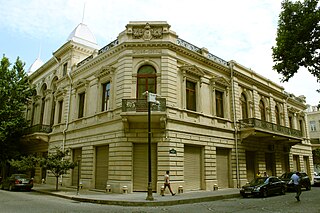
The National Museum of History of Azerbaijan is the largest museum in Azerbaijan, located in Baku, in the former mansion of Azerbaijani oil magnate and philanthropist Haji Zeynalabdin Taghiyev. It was founded in 1920 and opened to visitors in 1921.

Tourism in Azerbaijan has been an important sector of the Azerbaijani economy since the 1990s. According to Azerbaijan's Center for Economic and Social Development, the country is in 39th place among 148 countries in tourism competitiveness indicators. The World Travel and Tourism Council reported that Azerbaijan is among the top ten countries with the greatest increase in visitor exports from 2010 to 2016. The country had the world's fastest-developing travel and tourism economy in 2017. To promote tourism, Azerbaijan sponsored Atlético Madrid jerseys reading "Azerbaijan – Land of Fire". In 2018, a new tourism brand and a slogan "take another look" were introduced.
Azerbaijani art is the art created by Azerbaijanis. They have created rich and distinctive art, a major part of which is applied art items. This form of art rooted in antiquity, is represented by a wide range of handicrafts, such as chasing (metalworking), jewellery-making, engraving, carving wood, stone and bone, carpet-making, lacing, pattern weaving and printing, and knitting and embroidery. Each of these decorative arts is evidence of the culture and the abilities of the Azerbaijan nation, and are very popular there. Many interesting facts pertaining to the development of arts and crafts in Azerbaijan were reported by merchants, travellers and diplomats who visited these places at different times.

The architecture of Baku is not characterized by any particular architectural style, having accumulated its buildings over a long period of time.

Sabayil Castle is a submerged medieval fortress on the coast of the Caspian Sea near Baku, Azerbaijan.

The Palace of Happiness, currently also called Palace of Marriage Registrations and previously called Mukhtarov Palace, is a historic building in the center of Baku, Azerbaijan, built in Neo-Gothic style in the early 20th century.

The Ismailiyya Palace is a historical building that currently serves as the Presidium of the Academy of Sciences of Azerbaijan. It is on Istiglaliyyat Street in Baku.

Józef Płoszko was a Polish architect of the late 19th and early 20th centuries, and was the author of multiple architectural projects in Baku, Azerbaijan.

Sovetsky is a historic district in Baku, Azerbaijan. It is located in Yasamal raion, between Nariman Narimanov Avenue and Mirza Ibrahimov Street, and between Nizami and Ibrahim Abilov streets. There are many historical buildings over a century old, museums, mosques, baths and houses of notable Azerbaijanis.

Baku Fortress is the largest of Absheron fortresses. The fortress consists of the Icheri Sheher and the walls and towers surrounding it and it was included by UNESCO into the World Cultural Heritage List in 2000. It was built in about 1138–1139 on the order of the Shirvanshah Manuchohr III (1120–1149).

Palace of Zeynalabdin Taghiyev – Baku, H.Z. Taghiyev Street 4, previously owned by Baku millionaire Zeynalabdin Taghiyev, and now the palace building houses the National Museum of History of Azerbaijan. The building was constructed in 1893–1902 by civil engineer Józef Gosławski. The palace was Taghiyev's gift for his wife Sona khanim. The building covers a whole quarter in the central part of the city and has an ancient planning structure. The main symmetrical facade has been built in the forms of Italian Renaissance. During the construction of the palace, Goslawski used classic order, but some elements of the composition and interiors of the halls were inspired by Azerbaijani architectural traditions. Various architectural styles were used during the construction of the palace.

The Palace of Seyid Mirbabayev is a palace in Azneft Square, Baku, Azerbaijan. It was owned by Seyid Mirbabayev, a singer who became one of the oil millionaires of Azerbaijan. The building was built in the style of French Renaissance architecture based on the architect Pavel Stern's project. The plasticity of the facade, the shape of the architectural detail, the individuality of the stone procession, the building culture have shaped the aesthetic environment in the image of the building.

Shirvanshah's palace mausoleum or tomb of Shirvanshahs’ family is a historical monument of the XV century. Locating in Old City, it is a part of Palace of the Shirvanshahs complex. The mausoleum is one of the three buildings located in courtyard of the complex, the others being Shirvanshah's palace mosque and Shirvanshah's palace bath house.
Polish Architects Street is an alley located in the Sabail district of Baku, Azerbaijan. The alley was named after one of the alleys in the historic district of Baku in order to perpetuate the names of Polish architects.
